공지사항
-
- '노란봉투'캠페인/국제연대..
- no chr.!
Well, tomorrow, 8.31, the 2nd "Migrant Worker Film Festival" is starting in Seoul..

For more informations (program, "special events" etc.) please check out:
Yesterday in the late morning MTU, joined by activists from KCTU (Seoul RC), the 전철연/Federation Against House Demolition, "All Together" etc. demonstrated in front of Seoul's Immigration Office in Mok-dong. The activists, about 50 people gathered there, protested against the new intensified wave of crackdown - organized by the MoL/MoJ - against un-documented, so-called "illegal" (NO ONE IS ILLEGAL!!!) migrant workers in S.Korea (*).
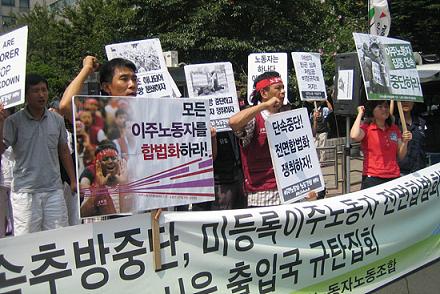
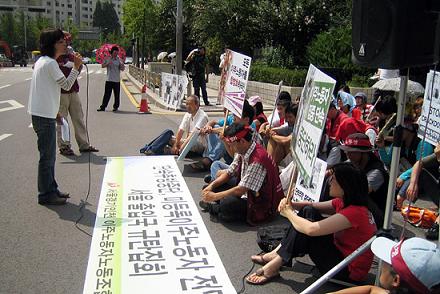
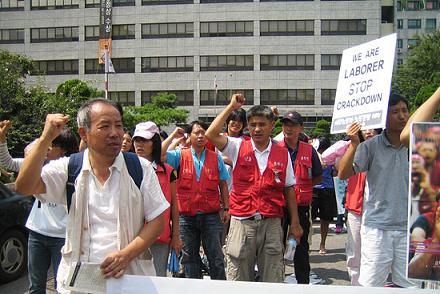
* 이주노동자 집중단속을 규탄하기 위해 이주노조는 28일 (화) 오전 11시에 서울 목동 출입국 관리소 앞 집회를 긴급하게 조직했다. 촉박한 일정에도 불구하고 호소에 응답해 목동으로 달려온 사람들은 50명이 훨씬 넘었다.
민주노총 서울본부, 전국철거민연합, 공감, 다함께, 이주인권연대 등 이주공동행동에 함께 하고 있는 단체들을 비롯해 필리핀 공동체 카사마코, 노동해방학생연대 학생들, 민주노총 정보통신산업노동조합 조합원, 장기투쟁사업장인 기륭전자 비정규직 노동자들, 코오롱 노동조합 조합원 등이 집회에 함께했다.
특히 이주인권연대 최현모 대표는 출입국 관리소의 이주노조 단속 논리를 요목조목 반박하며 법무부는 이주노동자를 범죄자 취급하지만 진정한 범죄자는 법무부와 출입국 관리소라고 비판해 참가자들의 열렬한 지지와 박수를 받았다.
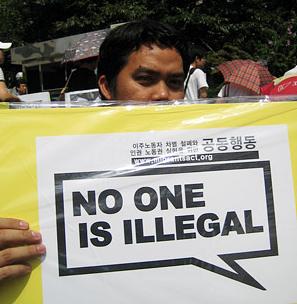
전국철거민연합 장영희 연사국장은 “이렇게 거리로 나오기 전에 평범하게 애 키우는 엄마였다”며 “애 아빠 다니는 회사에 이주노동자가 있었는데 부당한 대우를 받는 것이 없는 나라에서 사는 죄라고 당연히 여겼”었는데 철거민이 되어 내쫓기고 거리에서 10년을 싸우다 보니 이주노동자들이나 우리나 똑같이 없는 자로 짓밟히고 무시당하고 있는 거더라, 때문에 이주노동자와 우리가 함께 싸우는 것이 당연하다고 말하며 이주노동자 단속추방에 맞서 함께 싸울 것을 다짐했다.
Source: All Together/다함께
☞ [8월 28일] 이주노동자 집중단속 긴급 규탄 집회
Yesterday KCNA reported about the very latest news after the heavy flood disaster early this month in N.K.:
Tremendous Flood Damage in DPRK
The continuous torrential rain that hit all parts of the Democratic People's Republic of Korea from August 7 caused great manpower and material losses.
- Heavy rains registering more than 500-800 mm struck at least 150 cities and counties, claiming big casualties and losses in properties and doing serious damage to all the sectors of the national economy.
- According to the information available from the Central Statistics Bureau, torrential rain, strong wind and landslide left at least 600 people dead or missing and thousands of people wounded.
- Flood hit all parts of the country including Pyongyang city, North and South Hwanghae, Kangwon, South Phyongan and South Hamgyong Provinces, leaving dwelling houses for at least 240,000 families totally or partially destroyed or inundated. This left at least 100,000 people homeless and some 900,000 people flood-stricken.
- More than 8,000 public buildings, schools, thousands of health service institutions and nurseries were totally or partially destroyed in heavy rain, stopping their operation.
- More than 1,000 major production buildings of the country covering at least 200,000 square meters including the Komdok Mining Complex and the Taean Heavy Machine Complex were totally or partially destroyed or submerged, laying great obstacles in production.
- Torrential rain struck hard the agricultural field, making it hard to harvest crops as expected in some 200,000 hectares of arable lands.
- In particular, lots of arable lands were washed away, buried under silt or inundated in North and South Hwanghae, South Phyongan and Kangwon Provinces.
- The flood hit hard the power, coal and ore mining sectors.
- Dozens of transformer substations were submerged, over 800 electric poles collapsed and dam structures and generating facilities in Pujongang, Thongchon and other hydraulic power stations were destroyed or came under water.
- Nearly 300 pits and cutting faces and more than 170 mining faces were submerged in 90 odd coal mines in Tokchon, Pukchang, Chonnae and other areas and hundreds of thousands of tons of coal were washed away.
- Lots of pits and mining faces at Unpha, Yonphung and other mines came under water, bringing production to a halt.
- The flood also struck hard railways and other means of transport and city management.
- Some 100 sections of rail-roadbeds covering more than 78,000 cubic meters were destroyed, four tunnels inundated and more than 60 sections of retaining walls were collapsed and at least 200 sections of railroads were buried under some 62,400 cubic meters of earth due to landslide, thus suspending the operation in major sections of the railroad.
- The flood destroyed major roads and tourist roads extending some 600 km in at least 2,000 sections in Pyongyang-Kaesong motorway, Pyongyang-Wonsan tourist motorway and others and some 2,200 sections of bridges.
- More than 100 pumping stations for water supply, rainwater and sewage facilities were submerged to stop the supply of drinking water.
- The flood left at least 2,000 hectares of salterns inundated. It did serious damage to other fields of the national economy.
- The unusual heavy rain caused huge material losses to the DPRK, creating unprecedented difficulties in people's living and economic construction.
- The army and people of the DPRK are now turning out as one to recover from the damage with persevering will.
http://www.kcna.co.jp/item/2007/200708/news08/27.htm#1
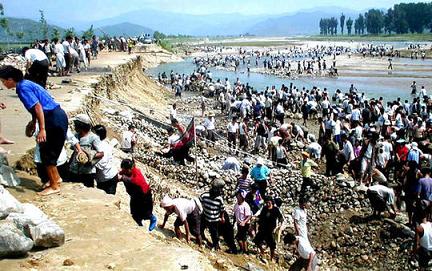
☞ Restoration Work with Bare Hands (DailyNK, 8.28)
(North) Korean Central TV, daily "news", 8.18
Surprisingly(^^) the..
..Performance of "Arirang" (is) Suspended (according to today's KCNA)
The grand gymnastic and artistic performance "Arirang" which was resumed on August 1 was suspended for the time being due to the unexpected torrential rain and flood damage.
It has now become hard to continue the performance as working people in different parts of the country are all out to recover from the flood damage these days.
The performance is expected to be staged again after the flood damage is cleared away.
http://www.kcna.co.jp/item/2007/200708/news08/28.htm#2
Last week, Monday and Tuesday(8.20/21), an "International Conference on Defending and Promoting the Basic Rights of Migrant Workers" (labour union/migrant workers' activists from Philippines, Malaysia, Japan, Spain, Nepal and South Korea participated) took place in Seoul. Today MTU(8.27) published the first contributions:
For more please read:
☞ International Conference to Defend and Promote the Rights of Migrant Workers in South Korea
The final resolution of the conference/meeting you can read here

A Korean report you can read here:
☞ 이주노동자 노동권 쟁취 위한 국제회의 열려 (이주노동자방송국)
2007.8.19 단속저지 합법화요구 결의대회(부산)

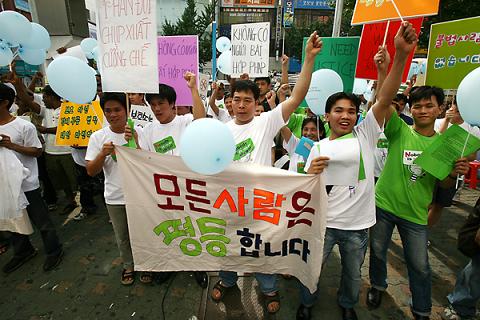
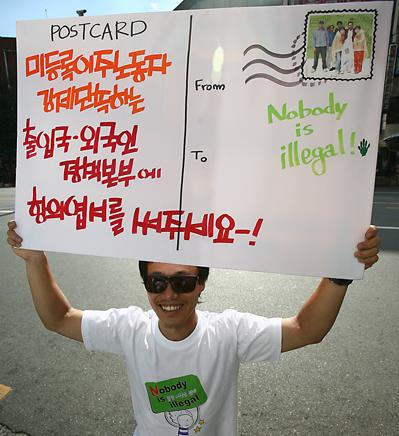
Related (about MTU's rally/demo in Seoul on the same day):
☞ "No employ approval but labor visa" (VoP, 8.21)
1992.8.24, ROSTOCK-LICHTENHAGEN
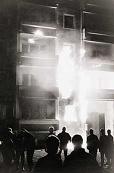
Today, 15 years ago, the racist mass riots in Rostock-Lichtenhagen, (north)East Germany,
after two days of excessive attacks against a
hostel for refugees (asylum seekers) and migrant workers reached its apex. Hundreds of nazis, supported/joined by thousands of "ordinary" citizens, mainly (german) neighbors of the hostel, tried to kill nearly 100 Vietnamese
migrant workers..
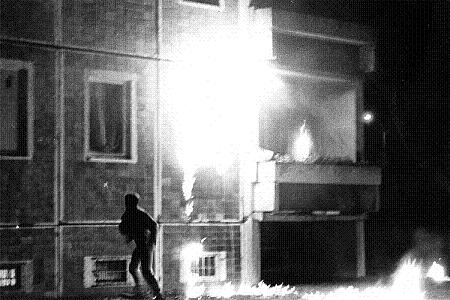
1992.8.24..

..the most horrific terror night against the house of Vietnamese migrant workers
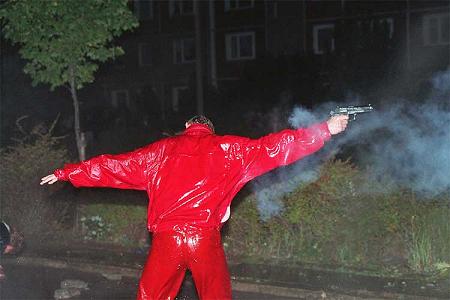
Attack with signal ammunition gun
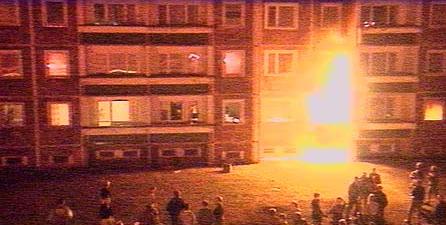
Massive fire bomb attacks

Burning barricades against the fire brigades and paramedics
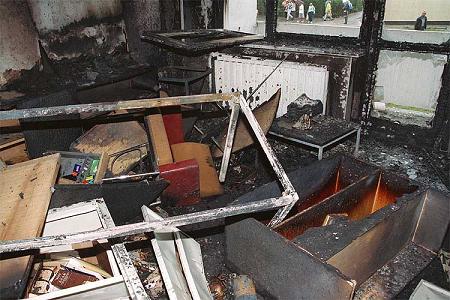
After the latest terror night: a living room for the Vietnamese migrant workers
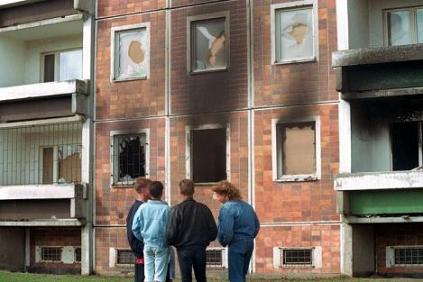
8.25: the day after the progrom
About the background and the detailed chronology you must read that !
Related:
☞ Le pogrom d’août 1992 à Rostock (French article)
☞ Als der Mob die Herrschaft übernahm (German article)
☞ Attacchi Nazisti #1 (Italian..)
☞ Attacchi Nazisti #2 (..docu..)
☞ Attacchi Nazisti #3 (..video)
☞ Lichtenhagen August 1992 (German video)
☞ Jewish leader sounds alarm after racist attack (Guardian, 8.23)
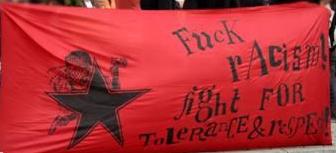
Last week(8.14) Asia Times published following report, written by A. Lenkov (just enjoy it!!):
Two countries, two systems, one porous border

The border between North Korea and China is more than 1,000 kilometers long. For most of its length the border goes along two rivers: the Tumen (Tuman in Korean pronunciation) and the Yalu (Amnok for the Koreans). Last month I made a trip along the border, and it was a very instructive undertaking indeed.
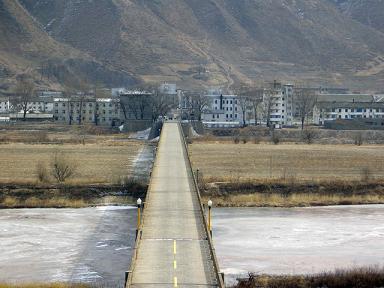
The border bridge between China and the DPRK (Tumen Riv.)
I was not alone. The borderland areas are popular with tourists, largely from South Korea. Chinese, usually from those parts of the country adjacent to Korea, come there too. Both Chinese and South Korean visitors love to ride boats that pass just a few meters from the North Korean shore, so people can throw cigarettes to North Korean patrols. Telescopes can also be rented for a few yuan to look across the river and get a glimpse at the neighbors.
It seems that Chinese often perceive these trips as a reminder that their country, in spite of manifold problems, is doing very well, and that there are places that look like a hell even compared with the provinces of northeastern China, which are relatively poor. Generally speaking, many Chinese see North Korea as a bizarre curiosity, a sort of living fossil reminiscent of China under Mao Zedong.
Actually, the borderland areas of both countries can be seen as relatively backward. For North Koreans, the far north of their country has always been the place of exile for people deemed politically unreliable. With the exception of some mines, Pyongyang did not invest much there, and it is no coincidence that the Great Famine of 1996-99 hit the area hardest; the authorities decided to sacrifice the local population as least useful and most expendable.
On the Chinese side, the borderland areas of Liaoning and Jilin provinces are also seen as underdeveloped - to an extent that this is seen as a political issue. However, it becomes clear from the first hours that the difference between what are considered poor regions might be as instructive as the difference between areas that embody success and prosperity.
The largest Chinese town on the Tumen River is small and sleepy Tumen, but this township presents a striking contrast with the impoverished lands across the border.
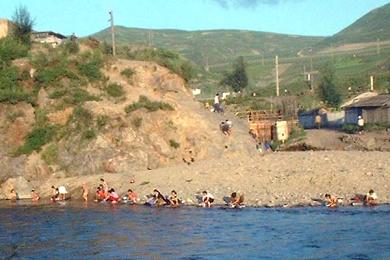
South (DPRK) of Tumen 'City' (China)..
However, a few decades ago, within living memory, the situation was the complete opposite. Until the early 1970s, North Korea was seen from China as a land of relative prosperity, so during the Chinese famine of the 1960s and the subsequent madness of the Cultural Revolution, ethnic Koreans from China often moved illegally across the border for the relative stability and affluence of Kim Il-sung's North Korea. There, at least, people were certain to receive 700 grams of corn every day.
Things have changed much since then: Deng Xiaoping's reforms in China launched an economic boom while North Korea stagnated and then began to slide backward, and by now the Chinese borderland areas have left North Korea far behind. Local Koreans who frequently visit their relatives on the other side of the border tell me that the situation in North Korea reminds them of China in the late 1960s, just after the failure of the Great Leap Forward.
Nowhere else is the difference as easy to see as in Dandong, a booming Chinese city just across from the North Korean city of Sinuiju. Dandong, with a population of some 2.4 million, is much larger than Sinuiju, which has 300,000 inhabitants. Dandong and Sinuiju are connected by a single bridge across the Yalu River sparsely used by both cars and trains. While more popular with tourists who like to go on it to snap pictures of North Korea, the bridge also serves as a transportation link between North Korea and outside world.

Dandong in China, just opposite of NK's Shinuiju..
Back in the 1970s, the two cities looked much the same, but now the difference is truly striking. The Dandong riverfront presents a spectacular picture of the post-socialist economic boom: highrise apartment complexes and office towers are being built everywhere, and a large river island is being turned into a resort development. The riverfront has been completely taken over by restaurants and hotels, as well as piers for small cruise boats (the thrill of going near the foreign shore seems to be irresistible to many Chinese).
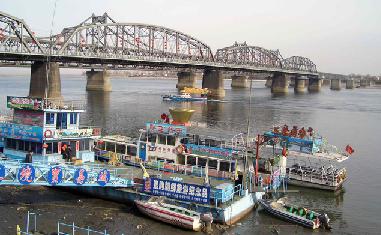
Dandong, the bridge between the North and the South (NK)
However, the Korean riverbank is empty and bare, with only the roofs of few derelict buildings, three or four stories high, to be seen behind the trees. An abandoned Ferris wheel serves as a reminder that leisure activities can take place in North Korea, too. The Korean riverbank is also a resting place for few rusty boats that probably have not touched the water for years, but otherwise it is empty. There have been reports about some construction going on in Sinuiju. This indeed might be the case, but no traces of any economic activity can be seen from the Chinese side of the river.

The same in the night time.. (right China, left..^^)
This contrast becomes even greater at night. Compared with Beijing and Shanghai, Dandong is not brightly lit, but it still has its share of city lights. The other shore is in complete darkness, and only some distant lights hint at a place where the local statue of Kim Il-sung is located (the Dear Leader's statues are brightly lit until late evening). The bridge that connects two cities looks surreal: at night it appears as if it abruptly ends in the middle of the river, since the Chinese half is lavishly decorated with colored lights, while the North Korean half of the bridge is unseen in darkness. One can only wonder what the inhabitants of Sinuiju think when they look at the other side, seeing bright lights in night and mushrooming buildings at daytime. After all, most of the new apartment complexes in Dandong look luxurious even compared with the government quarters in Pyongyang, let alone the buildings in the city of Sinuiju.
So it comes as no surprise that many North Koreans illegally move across the border to find work and refuge in China. Around 1999, when the disastrous famine stuck North Korea, the number of such refugees reached an estimated 200,000-300,000. Nowadays, the number has shrunk considerably, even though old figures are often uncritically cited by the world media. It is believed that some 30,000-50,000 North Koreans are currently hiding in China.
Why did their numbers go down recently? There are few reasons for that. To start with, a remarkable improvement of the domestic situation in North Korea played a role, but most of people with whom I talked in China last month agreed that the major reason for this change is the revival of North Korean border security in recent few years. Until 2004 or so, North Korean authorities usually turned a blind eye to the mass exodus of their people to China. Perhaps they believed that the border acted as a security valve by letting some people out. It is also clear that at the height of famine and economic disruption, they had no resources to control the border at the necessary level.
It seems, however, that most policies are initiated by the North Korean authorities, not by their Chinese counterparts. For most of its length, the border is in essence unguarded on the Chinese side. There have been reports about Chinese patrols or even fences being erected in the area, but it seems that such measures are taken only occasionally and in some relatively small areas. I traveled 300km along the border, and only once saw a military patrol (four or five uniformed men were sitting in the shadows near a small truck, obviously having fun). Marked police cars were encountered four or five times, and no checkpoints were ever seen.
Local Koreans insist that the Chinese authorities generally ignore border issues. According to them, a North Korean refugee has some chance of being arrested only if he or she is unlucky or does not know how to keep a low profile, but the overall probability of arrest is not very high.
The physical obstacles for a trespasser are not too formidable either, since the border waterways are both shallow and narrow. The Yalu in its lower sections is broad, but the Tumen remains a narrow stream for nearly its entire length, and the upper parts of the Yalu do not form an impressive obstacle for any border-crosser. For most of the border's length, both waterways can be easily waded over in many spots even by old or infirm people.
This creates an ideal environment for smuggling. Indeed, the area is frequented by North Korean traders. Until a few years ago, most of them were illegal border-crossers. In most cases they did not try too hard to avoid detection, since bribing the border guards was a better strategy. North Korean guards are ready to receive 800 yuan (US$105), an equivalent of their annual salaries, from professional smugglers to allow them to move bulky merchandise almost openly.
However, since about 2003 some North Koreans have been allowed to apply for permission to visit China regularly and come back with merchandise. On the other hand, all ethnic-Korean residents in Yanbian autonomous prefecture, home to many of the Korean-Chinese in Jilin province, now can go to North Korea any time they wish. Ostensibly, the goal of such trips is to meet relatives on the other side of the border, but it is an open secret that nearly all trips are, first and foremost, trading expeditions.
Of course, customs officials expect their fair share of both legal fees and bribes. Corruption in North Korea is shocking even to Chinese visitors, who are not exactly used to a clean government.
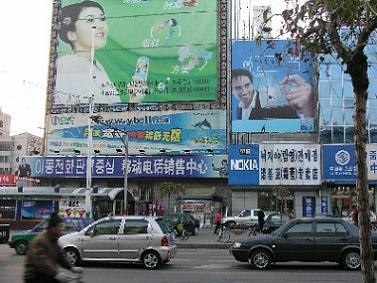
Yanji..
A Korean-Chinese who occasionally goes to visit his relatives described his usual experience: "They are so greedy. Officials take bribes in China, too. But perhaps nowhere in the world are the officials so hungry for bribes as they are in North Korea. At customs, they slowly go through the luggage and sometimes put aside a few things they like, and then they say that those things are not allowed into North Korea. This is the hint, and I have no choice but to tell them to take those things, some clothing or small items. And it is a tradition that everybody who checks you should be given some foreign cigarettes. Last time I took five cartons of cigarettes with me, and only one carton reached my relatives. All others I had to give away to the officials."
A particular role is played by the chogyo, North Korean citizens who permanently reside in China. This is a relatively small group, some 5,000-10,000 people (well below 1% of the ethnic-Korean community in China), but their economic and social role is out of proportion to their numbers. Their unusual legal standing allows movement between China and North Korea almost at will, and this means that they have great opportunities for very profitable trade.
A similar group, known as hwagyo, consists of Chinese citizens who are allowed to live permanently in North Korea. Hwagyo is a Korean pronunciation of Chinese characters that are read as huaqiao in Mandarin and used to describe overseas Chinese. There are also only a few thousand hwagyo, and in North Korea they enjoy a number of privileges, including the right to go overseas with relative ease. Nowadays, as my interlocutors never failed to stress, the hwagyo have become the most prosperous social group in North Korea. Being a hwagyo means to be rich, and this wealth comes from involvement in lucrative cross-border trade, both legal and illegal.
In a shopping mall in Dandong, I came across a shop that bears the proud name of a "joint Korean-Chinese venture". This is an excessively grandiose name for a small operation jointly run by two women in their 50s. One of the two owners is a chogyo while another is a hwagyo. This makes a perfect partnership. They can go back and forth to North Korea, even visiting Pyongyang when necessary.
The shop trades in paintings by North Korean artists who are willing to sell their works very cheaply. The buyers are overwhelmingly South Koreans who are happy to pay for the North Korean exotics. The works might look kitschy, but there is no doubt that they were produced with remarkable technical skill. The entrepreneurial ladies visit major fine-arts academies and state-sponsored institutions in Pyongyang, placing orders there.
Next to their shop one can see a number of others, also run by North Korean petty capitalists (often with hwagyo or chogyo backgrounds), that also sell North Korean souvenirs to South Korean visitors. It is remarkable, however, that the topics are quite non-political. Only after some explicit demand can a sales clerk produce something more politically charged - say, a Kim Il-sung badge (probably not a real thing, but a Chinese imitation).
Both Dandong and Yanji have shops that specifically cater to the tastes and demands of North Korean merchants and visitors. Usually, such shops are clustered on the same street, creating a sort of North Korean market area. The shop signs tell what the North Korean wholesalers usually buy: household goods such as refrigerators or television sets, calculators, notebooks, pens and other stationery items, mechanics' tools, fans and telephones, as well as small power generators and batteries - in recent years a measure of self-reliance for power supplies has become an important sign of an affluent household in North Korea. They also sell fashionable clothing and footwear, often to be copied by North Korean manufacturers.
Another major item of the illegal trade is the videotapes and discs with foreign movies and shows that are increasingly popular in North Korea. The North Korean authorities try to restrict the inflow of foreign, especially South Korean, movies, but the profits are too high. The North Korean population wants entertainment, and has had enough of biopics depicting the great deeds of the Dear Leader, Great Leader and their august family. In most cases, entrepreneurs in China record the South Korean serials that are shown by the local TV networks almost daily, and then sell the recordings to the smugglers.
The border is also a major source of information for North Koreans. Since the 1960s, the North Korean authorities have exercised information control that is exceptional even by communist standards. North Koreans can go to prison if they are discovered to possess radios with unlocked tuning. All foreign publications (including those from "fraternal" communist regimes) are sent to the closed sections of the libraries, to be accessed only by the carefully selected owners of special permits, and even a trip outside one's native county is impossible without formal permission. Until recently, this system held, but changes in the borderland areas brought about a gradual disintegration of the North Korean information blockade.
Throughout the past decade, an estimated 500,000 North Koreans have been in China, overwhelmingly in the borderland regions, both legally and illegally. They have seen Chinese reforms, and they do not buy the official North Korean propaganda anymore. They are also skeptical about statements by Beijing ideologues who still describe China as a "socialist society". For them, modern China is an embodiment of capitalism, pure and simple, and also a demonstration of capitalism's efficiency and success.
A representative of a small non-governmental organization who has worked in the area for a decade told me how North Korean low-level officials typically react to China during their first visit: "They literally do not sleep their first night. They are overwhelmed by this prosperity, these lights, this abundance of food, this relaxed behavior of people." One has to keep in mind that this particular NGO operates in Tumen, a city that is clearly poor and underdeveloped by Chinese standards.
In many cases, North Koreans can see signs of Chinese success even without crossing the border. At nighttime, the bright sky over the Chinese towns is seen for dozens of kilometers, and in daytime one can easily see the many construction sites on the banks of the border rivers.
What is more important, the Chinese borderland serves as a conduit of information about South Korea. The South Korean presence in the area is remarkable, and at any given moment one out of 10 Korean-Chinese is in South Korea, working, studying or doing business there. Therefore, the border-crossers soon learn that South Korea, routinely depicted in the official Northern media as a living hell, is actually richer than China, which looks to them like a perfect paradise. They sometimes buy and secretly watch "subversive" South Korean movies and shows that are frequently broadcast by the local Chinese stations. This new information is penetrating the North, and recently it has become clear that even the notoriously shameless and inflexible North Korean propaganda machine has had to change its tune somewhat to adjust to this new knowledge.
The border is not really sealed anymore. The difference in living standards is large and growing, and this can be easily seen. We can only surmise when the effects of this new situation will be felt, but there are good reasons to believe that the borderland areas will play a major role in the future of what is now known as the Democratic People's Republic of Korea.
http://www.atimes.com/atimes/China/IH14Ad01.html
Related article:
☞ The gentle decline of the 'Third Korea'
BERLIN:

EVERY THIRD
CHILD IS POOR
Drastically increase of children poverty in the city!
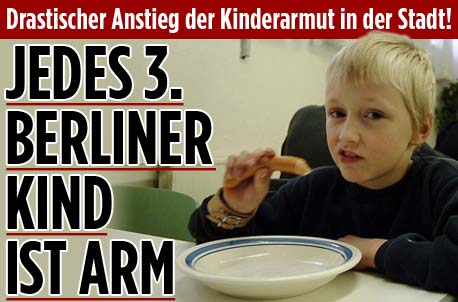
That's not "communist" propaganda against the capitalist reality - that's just today's front page and main story of the bourgeois BZ, THE mass circulation newspaper in Berlin..
Germany:
RACIST/FASCIST TERROR AGAINST MIGRANT WORKERS
Actually there is no day passing in Germany, especially in the Eastern part (the former GDR), without racist/fascist attacks against foreigners/migrant workers (but "of course" also against Germans with the "wrong" skin colour, or people just wearing the "wrong" clothes/hair style etc..). A short while ago Chinese students were attacked in a train in East Germany and later kicked out.. About twentie days ago a Vietnamese family was attacked in their home in Burg (Sachsen-Anhalt, E. Germany). There, after the attackers destroyed the entrance, the two children of the family (14 years old son and 9 years old daughter) were beaten, while the attackers shouted racist slogans, according to Junge Welt (8.04).
But last weekend, in the night from Sat. to Sunday a "special event" took place in a small town in Saxony (Sachsen): dozens of Germans, armed with knifes, clubs and pepper spray, hunted a small group of Indian migrants during a street party, the so-called Old City ("culture") Celebration.

"It was like a small peoples' uprising"
The hunted migrants were able to hide in a pizzeria, owned by a friend, but the fascist crowd, now joined by many "ordinary" citizens wanted to get in by force, destroying doors, windows of the restaurant and the car of one of the owners. Meanwhile, according to eye-witnesses, the increasing crowd of "audience", i.e. "ordinary" citizens (Tagesspiegel, 8.20), applauded and shouted slogans like: "Foreigners out!", "Here rules the national resistance!" etc.. One witness later said: "On the end almost everyone joined the riot.. It was just like a small peoples' uprising."
"No, here, in our small beautiful town we have no racist scene"
Even today, two days after the attack, the representatives, such as the mayor of Mügeln, are denying that "this unfortunate incident" is caused by a "spread racism here". "In our town we have no racist and fascist structures!", the mayor said in several interviews.
But, according to anti-racist activists based in the region, in the past there were several nazi concerts held in the town and everywhere you can see the fascist graffitties praising the "NSDAP", the "National Resistance" etc..
But finally neither the mayor of the town, nor the representatives of the federal state are interested to fight against the fascism there - they're just worrying about the "bad image" of their state/country/town..
The German bourgeois magazine Der Spiegel published y'day following article:
MOB RULE IN EASTERN GERMANY
Indians Attacked by Crowd at Street Party
A group of eight Indians was attacked by a mob at a street party in eastern Germany on the weekend. All were injured, one seriously. The police deny there was a political motive behind the attack despite calls of "foreigners out."
Despite a mob's calls of "foreigners out," police are denying there was a far-right motive behind an attack on a group of Indians in eastern Germany this weekend.
The eight men were attacked by a mob of around 50 Germans at a street party in the early hours of Sunday in the small town of Mügeln in the eastern German state of Saxony. The trigger for the violence was a brawl on the dance floor in a party tent shortly before 1 a.m., police said. The reason for the brawl was not yet clear.
The Indians left the tent where the dance was being held but were then attacked by the mob, which chased them across the town's market place until they took shelter in a pizzeria run by an Indian. The owner let them in, but the mob tried to kick in the doors of the restaurants as a large crowd looked on. The restaurant owner's car was also seriously damaged.
Seventy police officers were called in to restore order. Fourteen people were injured in the incident, including the eight Indians, four of the attackers and two police officers. One of the Indians and one of the attackers were taken to hospital for treatment. Two of the attackers, aged 21 and 23, were arrested on Saturday night but later released. The police have set up a task force to investigate the incident.
In remarks to the German news agency DDP Monday, a police spokeswoman in Leipzig denied there was a neo-Nazi motive behind the attack, despite eye-witnesses accounts of people calling for "foreigners out."
There were reports Monday that the police had been warned in advance of the attack but had done nothing to prevent it. Mayor Gotthard Deuse told the German news station N24 that there had been warnings of possible problems at the street party. However, the police spokeswoman denied this, saying that the warning in question had been sent to a youth club in the town, warning of a robbery. This had "absolutely nothing to do" with the attacks, the spokeswoman said. The mayor said there were no neo-Nazis in the town and that, if the incident did have a far-right motive, it was most likely caused by people from outside the city.
Some of the men were merchants living in the area, police said. "They just wanted to take part in the celebrations," a police spokesman told the Associated Press.
Attacks on foreigners are far from unusual in eastern German states such as Saxony, where there are concerns that far-right groups are gaining in strength and taking on institutional roles in some places. The far-right, neo-Nazi National Democratic Party (NPD) holds several seats in Saxony's state assembly, having won over 9 percent of the vote in the 2004 state election.
http://www.spiegel.de/international/germany/0,1518,500879,00.html

☞ Racist Manhunt in Small-Town Germany
☞ After Attack on Indians, Germany Fears For its Reputation
☞ Far-Right Views Established Across German Society
Related articles:
☞ Neo-Nazis Attack Theater Group in Eastern German Town
☞ Neo-Nazis on Trial for Burning Anne Frank's Diary
☞ Severe Anti-Semitism Hits Youth Football in Germany
*****
☞ Lack of Women in Eastern Germany Feeds Neo-Nazis
*****

Yesterday afternoon about 500 activists demonstrated in front of Seoul Stn. for full human and labour rights for migrant workers in S. Korea. Among MTU activists members of (mainly student) solidarity groups, some reprensentatives of KCTU and Democratic Labour Party, activists of E. Land Workers' Union, the Federation Against House Demolition, "All Together" etc. protested against the continuing policy of crackdown - once again, since the beginning of August, the S.K. gov't is trying to hunt, arrest and deport masses of migrant workers.
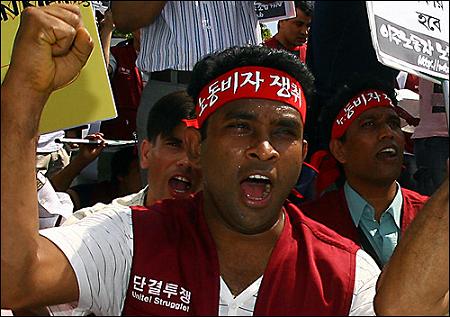
"Bangladeshi migrant workers rally for better rights in front of Seoul
Station on Sunday" (Chosun Ilbo, 8.20)
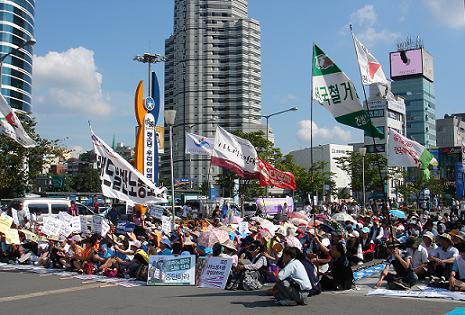
(사진: 노동의소리)
Related articles:
☞ "인권유린하는 고용허가제, 폐지하라" (VoP)
☞ "이주노동자를 합법화하라" (OhmyNews)
☞ 고용허가제 시행 3년 규탄! 단속추방 중단! .. (다함께, report & pics)
☞ 이주노동자.. 대회 (이주노동자방송국)
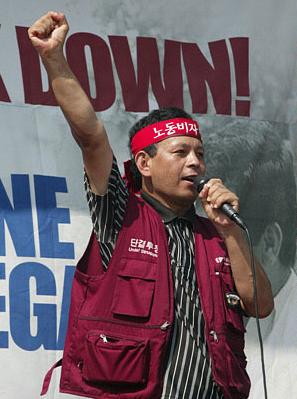
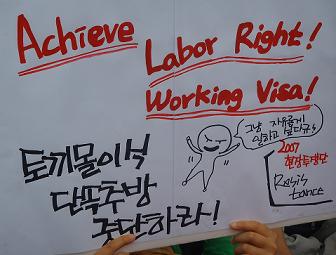
덧글 목록
관리 메뉴
본문
읽을 수 없는 데 사진으로 전해지네요.부가 정보